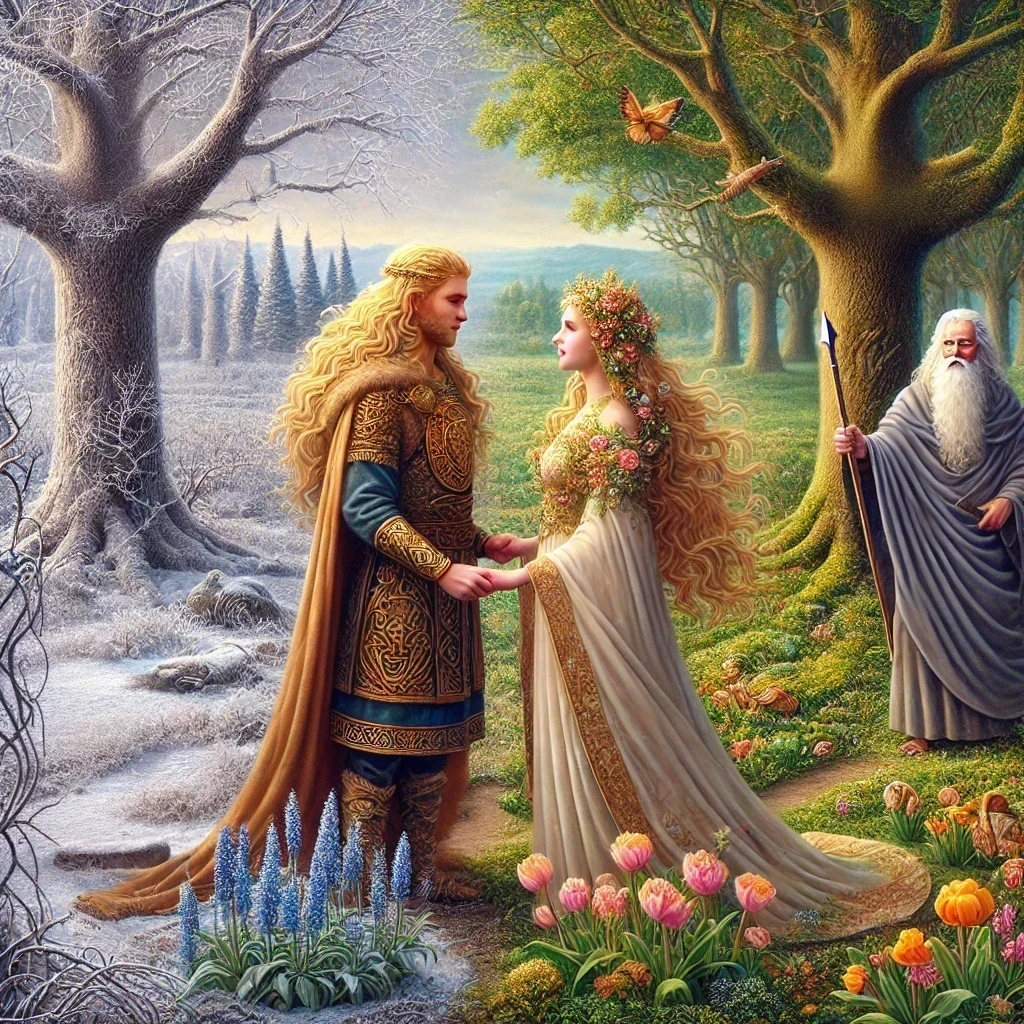Table of Contents
Āwæcnungdæg: The First Day of Foran-lencten
The festival begins with Awakening Day, dedicated to the awakening of Gerd, the Goddess of the frozen Earth of the cultivated enclosure, and her symbolic retrieval by Ing-Frea, the god of fertility and growth. This day celebrates romance, love, and fertility, as Ing-Frea courts Gerd, bringing warmth and life back to the earth after the cold slumber of winter. Participants honor this day with feasting, music, and rituals that emphasize the renewal of life and the reawakening of nature’s beauty. It is a time to reflect on new beginnings, celebrate love, and plant the seeds of future growth. The legend of the courting of Gerd involves Ing-Frea (the Anglo-Saxon equivalent of ON Freyr or Dutch Froh) and Gerd (Dutch Gerda, or ON Gerðr). In this tale, Ing-Frea, the god of fertility and growth, falls deeply in love with Gerd, a beautiful figure associated with the earth.
Ritual Roles
For the purposes of creating a template, the active roles have been divided up as though there was a primary organizer of the ritual, and one or more helpers. This may in actuality be a single person. Again, discretion will need to exercised in deciding how best to divide up these roles in your situation.
Blótere (Sacrificer) The principal priest for this occasion, possibly the host or the maintainer of the altar, or the Ealdor in an organized group.
Hālgere (Consecrator) The person responsible for the opening cleansing rite. This might be the Blótere, or another person.
Wígbed-þegn or Húsel-þegn (Altar Thegn) – A participant with speaking role, possibly an ordained Heargweard, head of household, or simply a celebrant with a strong interest in active participation in this rite.
Outline
- Opening: The Blótere begins the ritual near the fire, with the celebrants gathered around, each holding a candle or torch.
- Hallowing: The ritual récels-fæt (incense burner) is kindled, and the bounds of the area are censed with Mugwort or another appropriate form of récels.
- Invocation and Prayer: The Blótere invokes the deity (Woden) and articulates the purpose of the gathering, possibly using the supplied verse.
- Initial Drink: The Blótere drinks from the ritual vessel, symbolizing the initial offering and communion with the divine.
- Passing the Drink: The vessel is passed among participants, each adding their own prayers or thoughts before drinking.
- Libation: After the vessel circulates, the Blótere pours a portion of the drink as a libation into a sacrificial bowl, dedicating it to Woden.
- Closing and Transition to Húsel: With the formal ritual acts completed, the Blótere closes the ceremony, thanking Woden and participants. The transition to the banquest portion is marked, perhaps with a final blessing, including formal bletsung if desired.
- The Húsel-gang (Communion Meal): The celebrants gather for a communal meal, which serves as both a grounding activity and a continuation of the ritual’s communal aspect. This meal can include foods that are symbolic of the ritual’s themes, such as breads (representing the earth’s bounty) and seasonal local produce. The repast offers a time for reflection, sharing experiences of the ritual, and further bonding among participants.
- Final Blessing or Farewell: Conclude the gathering with a final blessing or words of farewell, ensuring that the ritual space is properly closed and participants leave with a sense of closure and renewal.
Hallowing the Feast (Húsel-hálgung)
After the Blótere has made their opening remarks , the hālgere, holding the firepot with burning mugwort, begins to walk around the perimeter of the ritual area to consecrate the space:
Anglo-Saxon
Wendende mid þisum weorþan wyrt,
Weardende weallas þisses woruldlican stedes.
Fynd fleoð fram þam fýre halgan,
In þissum healle, gehalgod, sylfnes asend.
Mucgwyrt, mihtig, meodo þis stede gesund!
Ealdfæderas, būr geblētsian, befæstan þis brīde stede!
Thunor, hālgie þū! Thunor, hālgie þū! Thunor, hālgie þū þis weohfod!
Modern English
Wending with this worthy wort,
Warding walls of this worldly stede.
Fiends flee from the sacred fire,
In this hall, hallowed, safety sent.
Mugwort Mighty, make this stead safe!
Ancestors bless this dwelling, secure this bright stead!
Thunor, hallow, Thunnor hallow, Thunor hallow this Altar place!
Prayers (Bedræden)
The Blótere or primary conductor of the rite, pours a cup or horn full of the ritual beverage, and speaks this prayer or another suitable one:
The gathered celebrants may echo the final prayer, “Wōden, ūre lāc þū onfōh!”
Ritual Pouring of Drink (Scenc)
The Blótere then drinks in honor of Woden. The drinking vessel is passed, or if this is not feasible, willing celebrants approach the altar and take the vessel, offering their own prayer, drinking, and then offering their own libation.
Sacrifice of Drink (Wín-tiber)
When this is complete, the Blótere pours Woden’s portion in to the húsel-fæt. He or she may wish to speak some final words of offering.

